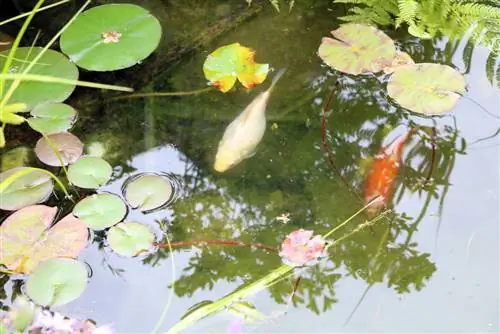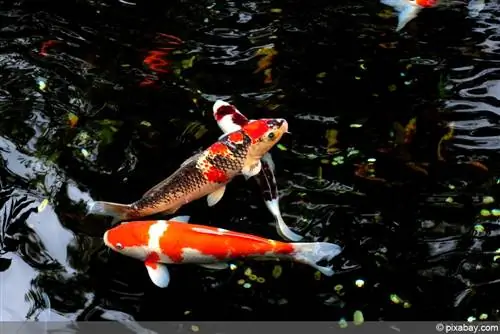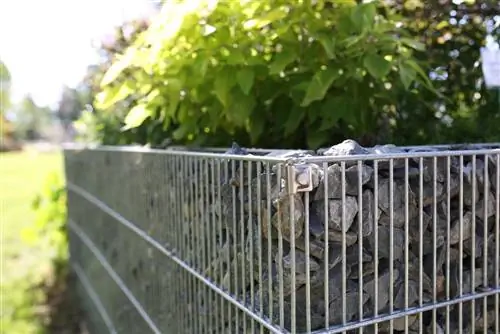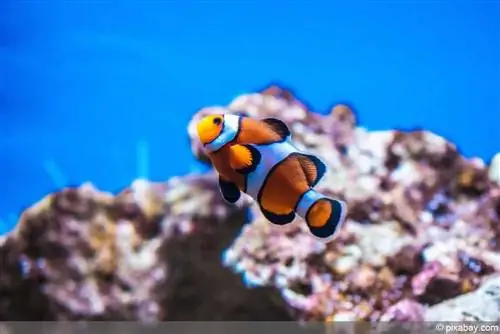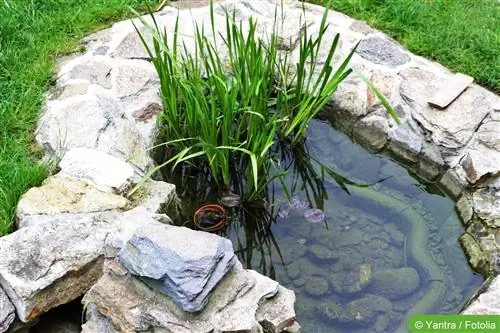- Author admin [email protected].
- Public 2023-12-17 03:39.
- Last modified 2025-06-01 06:48.
A well-maintained garden pond is an oasis of peace and relaxation. Here you can sit comfortably on the bank and watch nature: how the koi carp and goldfish swim curiously to the surface, how the pond frog sits on the lily pad and catches flies whizzing by, or how a dragonfly buzzes over the surface. However, in order for animals and plants to feel comfortable, the pond volume must be calculated correctly.
Garden ponds age quickly
Calculating the size of the pond is important for various reasons, and not just if you want to put fish in it. All garden ponds - even unoccupied ones - age over time. In the originally clear water, first unicellular, later filamentous algae and finally underwater plants develop quickly. In addition, the pond becomes muddied over the years and the water becomes cloudy and opaque. For unoccupied ponds, experts expect an average lifespan of around 14 to 20 years if a filter is not used. If, on the other hand, the pond is filled with fish, the water has to be completely renewed after about four to seven years. A pump and filter system tailored to the size of the pond and the stocking increases the service life considerably, but the type and performance of the technology used depends specifically on the existing pond volume.
Why calculating pond volume is so important
The size and amount of water of the garden pond are also important for selecting the types and quantities of fish. Different types of fish need different amounts of space depending on their size, and how many specimens of a species can fit depends on the size and depth of the pond. The pond volume is also so important because the animals naturally get sick and need medication. The amount of medication in turn is calculated based on the amount of water available in the pond - without a specific volume specification, correct medication administration is not possible. Furthermore, the following requirements make the calculation of the pond volume so relevant:
- Selecting a suitable filter and pump system
- Selecting a suitable pond sludge vacuum cleaner
- Calculation of the type and quantity of fish stocking
- Calculation of species and quantity of planting
The larger the pond volume, the more stable the ecological balance
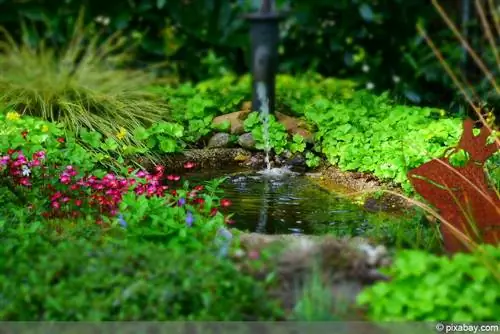
In addition, the depth of a garden pond (but also its volume) determines whether it is suitable for overwintering fish or not. The basic rule here is that the smaller the volume and the shallower the pond, the greater the risk of freezing - and the fish therefore have to move to winter quarters during the cold season. A koi pond, for example, must be at least 150 to 200 centimeters deep and contain around 1000 liters of water per fish so that the animals can spend the winter there.
How much space do fish need in a garden pond?
In general, the popular colored carp require a lot of space: young fish, usually no more than 10 centimeters long, initially feel very comfortable in smaller ponds, but within a few years they grow to an impressive length of 70 to 80 centimeters - and therefore need space. Therefore, you should not adjust the size and volume of the garden pond to the size of the young fish, but rather to its expected final size. Goldfish - which only grow to around 30 centimeters long on average - require significantly less space, as do golden orfe, minnows, lizards or veiltails.
Many fish are school animals
However, keep in mind that many of the species mentioned are school animals that only feel comfortable in groups of ten or more fish. Sturgeons require a particularly large amount of space and are particularly popular with lovers of special fish. These animals live primarily at the bottom of the garden pond and can grow to between two and three meters long within a few years. Therefore, a volume of at least 250 cubic meters and a pond size of six by twelve meters are necessary per fish.
Formula for calculating fish stocking
You can calculate the ideal fish stock using a simple formula: To do this, plan around half a kilogram of fish per cubic meter of water (i.e. 1000 liters). Remember that fish grow quickly and increase significantly in size and weight over the years.
Average size and weight information for pond fish
- Goldfish: up to 40 centimeters long, weighs up to approx. 2.5 kilograms
- Koi: up to 90 centimeters long, weighing up to approx. 12.5 kilograms
- Minnow (bitterfish): up to approx. 14 centimeters long, weighing up to approx. 20 grams
- Veil tail: up to 30 centimeters long, weighs up to approx. two kilograms
- Shubunkin: up to 30 centimeters long, weighs up to approx. two kilograms
In addition, not the entire water volume of the pond may be used to stock fish. You must reserve the first 1000 liters for planting, another (depending on the specific floor area) for the ground covered with stones and gravel, as well as around 500 to 1000 liters of hidden reserve - for example for the offspring of fish that will inevitably come.
How to calculate pond volume
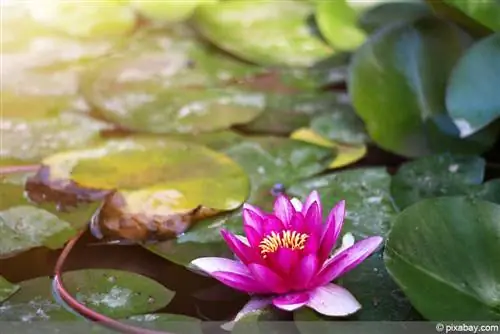
Theoretically, calculating the pond volume is very easy because you just have to measure it and then multiply its length, its width and its depth together. The result is the pond volume in cubic meters, which you can multiply again by a factor of 1000 to get a volume in liters. However, this very simple formula is only suitable for rectangular ponds with side walls that slope straight down, without any shallow water areas (which would have to be calculated separately) and without any plant or inorganic stock.
Calculate pond volume of irregular ponds
However, since a garden pond rarely has the strictly rectangular shapes of a water basin like in a swimming pool, but instead has very irregular dimensions and different water depths, the above formula is only of limited use for calculating the water volume. Typical garden ponds are measured and calculated as follows:
- Measure the length, depth and width at 50 centimeter intervals.
- This will give you several values from which an average value can be calculated.
- To do this, add all the values of one size and divide the result by the number of measurements.
- If you have the three required values, multiply them and get the volume.
- Multiplying this again by a factor of 1000 gives the pond content in liters.
This form of calculation can of course only be an approximate value, but not the absolutely correct volume.
Example calculation:
- Three measurements were taken at depth: 0.6 meters + 1.5 meters + 1.2 meters=3.3 meters
- Average depth of garden pond: 3.3 meters / 3 measurements=1.1 meter
The width and length were calculated equally, giving an average width of five meters and an average length of twelve meters.
The number of cubic meters and thus the water content can now be calculated: 1.1 meter x 5 meters x 12 meters=66 cubic meters=66,000 liters of water.
Tip:
Installing a water meter when creating a new pond
So that you not only get an approximate value, but also the correct water content, you can install a water meter when you create a new pond and read the amount of water that has been added. However, the number of cubic meters fluctuates over time, for example because water evaporates, seeps away or is absorbed or displaced by plants or animals.
Other factors that influence pond volume
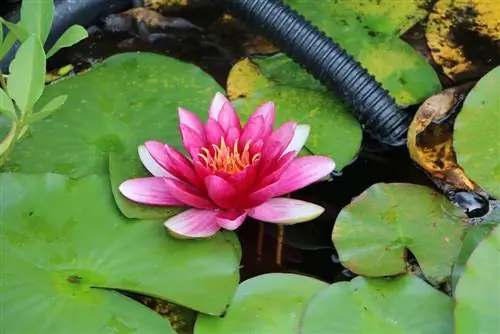
So that the calculated approximate value comes even closer to the actual one, you must also consider factors such as the location, the plants, the thickness of the pond bottom and any (decorative) objects such as larger stones in your calculation. Of course, these must be taken into account in the calculation and thus in the volume information.
Example
In locations with direct sunlight, pond plants grow much faster and more lushly than in darker ones. Therefore, for a garden pond in full sun, increase the calculated pond volume by a quarter. Regarding the example above, the calculation would look like this:
66 cubic meters x 25 percent / 100=16.5 + 66 cubic meters=82.5 cubic meters
Formula for round ponds
Round garden ponds are calculated differently than the classic square orIrregular variants: Here you calculate length x width x depth and multiply the result again by a factor of 2. Only now do you get the pond volume in cubic meters.
Tip:
A stable fish pond contains at least 90 to 100 cubic meters of water and is also suitable for overwintering, larger fish species. When choosing species, remember that not all fish get along with each other (sturgeons and koi, for example, should not be kept together) and that a large mix of different fish can tip the ecological balance more quickly. Therefore, limit yourself to a maximum of two to three species (in larger ponds) or a single species (in smaller ponds).


